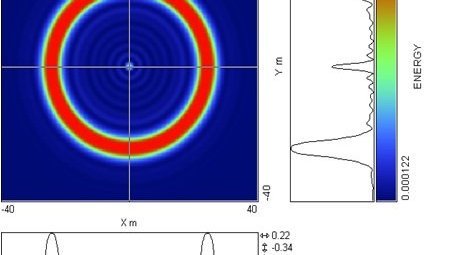Hollow Reflector for GNSS Satellites
The Laser Retro Reflector (LRR) onboard a spacecraft for a Global Navigation Satellite System (GNSS) has to be designed in a way that it delivers sufficient return energy to the SLR station for all possible ranging geometries between satellite and ranging system. An important effect to be compensated for is the velocity aberration of the laser light which is caused by the orbital movement of the satellite and is about 2v/c with v the spacecraft velocity and c the velocity of light. As an example, the velocity aberration for the Galileo orbit is between 21 and 24 µrad. In case no measures are taken to compensate for this effect within the LRR design, the returned laser signal would miss the ground station by several hundred meters. Because of the large distance of GNSS satellites to the laser ground stations (> 19000 km), the return signal strength is weak anyhow, and all measures shall be taken to enable laser ranging at sufficient signal strength and with good accuracy.
Standard LRRs for GNSS satellites feature large arrays of single quartz prisms in order to obtain the required signal strength. The usual method of compensation for the velocity aberration effect is the use of prisms with proper aperture and with no aluminum coating at the backside which are arranged in a dedicated way within the array. The far field diffraction pattern of such an ensemble of individual prisms yields a circular structure with most of the energy concentrated within the central lobe which is not accessible by the Satellite Laser Ranging (SLR) stations due to the velocity aberration. The homogeneous outer ring contains the useful signal which is very weak.
The main disadvantages of such a large planar multi-prism array are:
- The required area on the nadir side of the GNSS satellite is relatively large.
- The full ranging accuracy of a given SLR station is obtained only for high elevations of the GNSS satellite when the light incidence is about normal to the array. For lower elevations, the array is inclined and the returned laser signal is composed from photons of different prisms at different distances from the station; thus the pulse is spread and the ranging accuracy decreases.
These disadvantages of a large planar multi-prism array can be overcome by the use of a single element hollow reflector which is presently investigated in cooperation between GFZ Potsdam and SpaceTech GmbH Immenstaad.
Such a single hollow reflector shall consist of 3 orthogonally arranged plates of glass ceramics (e.g. Zerodur™) with a reflective surface coating. The aperture of the proposed single reflector is between 16 – 20 cm.
Due to this much larger aperture in comparison to a conventional quartz prism, the far field diffraction pattern for this reflector is much sharper and nearly all the reflected energy can be concentrated into the concentric ring by proper shaping of the reflecting surfaces. The return signal of a single large hollow reflector is expected to be 2 – 4 times stronger than for a conventional array with 80 prisms.
Additional advantages of such a reflector design are:
- Less space is required on the nadir side of the satellite than for a conventional flat array
- Only a single optical element contributes to the reflected signal, thus no pulse spreading at lower satellite inclination will happen and the ranging accuracy depends only on the parameters of the SLR station.
The main problem of large optical apertures is their sensitivity to thermal deformations under the conditions of various in-orbit conditions with respect to solar irradiation or deep space exposure. It is expected that these issues can be overcome by the use of novel optical materials in connection with a proper space-proven mechanical design.
Details of the proposed design can be found here .



